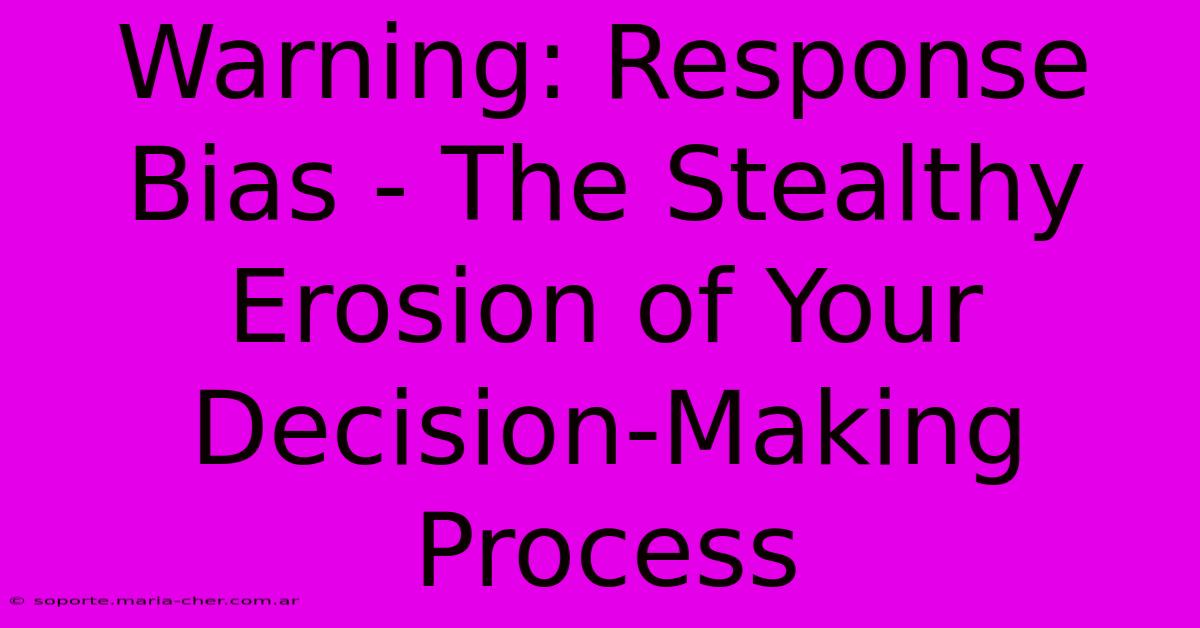Warning: Response Bias - The Stealthy Erosion Of Your Decision-Making Process

Table of Contents
Warning: Response Bias - The Stealthy Erosion of Your Decision-Making Process
Response bias. It sounds technical, maybe even a bit boring. But the reality is, this insidious psychological phenomenon is silently undermining your decisions, impacting everything from your personal choices to your professional strategies. Understanding response bias is crucial for anyone seeking to make truly informed and objective decisions. This article delves into the various types of response bias, their subtle influences, and importantly, how to mitigate their effects.
What is Response Bias?
Response bias, in its simplest form, refers to the systematic pattern of deviation from truth or accuracy in responding to a question or stimulus. It's a cognitive shortcut our brains employ, leading to inaccurate or misleading answers. These biases aren't necessarily intentional; they're unconscious tendencies shaped by our experiences, beliefs, and the context of the situation. The problem? These seemingly minor deviations can lead to major errors in judgment.
Common Types of Response Bias: Understanding the Culprits
Several types of response bias exist, each with its own unique mechanism:
-
Acquiescence Bias (Yea-Saying): This is the tendency to agree with statements regardless of their content. Think of surveys where respondents consistently check "agree" even if the statements contradict each other. This bias is particularly prevalent in situations where respondents feel pressured to conform or are unsure of the correct answer.
-
Social Desirability Bias: This bias involves answering questions in a way that presents oneself in a favorable light, even if it means sacrificing accuracy. People tend to over-report positive behaviors and under-report negative ones.
-
Confirmation Bias: One of the most well-known cognitive biases, confirmation bias is the tendency to favor information that confirms pre-existing beliefs while ignoring contradictory evidence. This can lead to flawed conclusions and reinforce existing prejudices.
-
Order Bias: The order in which questions are asked can influence responses. For example, a question about job satisfaction might be answered differently depending on whether it's preceded by a question about work-life balance.
-
Recall Bias: This refers to the difficulty in accurately remembering past events, leading to skewed responses when recalling information for surveys or interviews.
The Real-World Impact of Response Bias: Beyond the Survey
The consequences of response bias extend far beyond the confines of a simple survey. Consider these examples:
-
Investment Decisions: Confirmation bias can lead investors to hold onto losing investments longer than they should, ignoring warning signs and reinforcing their initial beliefs.
-
Hiring Processes: Unconscious bias in interviews can lead to unfair hiring decisions, perpetuating inequality in the workplace.
-
Market Research: Inaccurate responses to market research surveys can lead to flawed product development and marketing strategies.
-
Legal Proceedings: Eyewitness testimonies are notoriously susceptible to response bias, leading to miscarriages of justice.
Strong evidence suggests that response bias plays a significant role in many decision-making scenarios.
Mitigating the Effects of Response Bias: Taking Control
While we can't eliminate response bias entirely, we can significantly mitigate its impact. Here are some strategies:
-
Careful Question Design: For surveys and questionnaires, design questions carefully to avoid leading questions and minimize ambiguity. Use neutral language and avoid emotionally charged terms.
-
Randomization: Randomize the order of questions and response options to reduce order effects and minimize the impact of acquiescence bias.
-
Anonymity and Confidentiality: Ensure respondents feel safe and comfortable to provide honest answers by guaranteeing anonymity and confidentiality.
-
Blind Studies: In research settings, use blind studies to minimize researcher bias and ensure objectivity.
-
Triangulation: Employ multiple data sources and methods to cross-validate findings and identify potential biases.
-
Self-Reflection: Develop a habit of critically evaluating your own thinking process. Ask yourself if your judgments are influenced by biases and seek out diverse perspectives.
Conclusion: Embrace Critical Thinking for Better Decisions
Response bias is a pervasive and powerful force that subtly shapes our decisions. By understanding its various forms and employing strategies to mitigate its influence, we can move closer to making more objective, rational, and ultimately, better decisions. The key is to foster a culture of critical thinking and actively challenge our own assumptions and biases. Only then can we truly navigate the complexities of life and decision-making with greater clarity and confidence.

Thank you for visiting our website wich cover about Warning: Response Bias - The Stealthy Erosion Of Your Decision-Making Process. We hope the information provided has been useful to you. Feel free to contact us if you have any questions or need further assistance. See you next time and dont miss to bookmark.
Featured Posts
-
Urgent You Tube Sensation Warns Of Impending Tech Disaster
Feb 07, 2025
-
Unlock Your Inner Collector How The Endowment Effect Can Boost Your Value
Feb 07, 2025
-
Revolutionize Classrooms With Digital Streaming A Guide For Ed Pros
Feb 07, 2025
-
Attention Disney Enthusiasts Meet The Visionaries Behind The Iconic Disneyverse
Feb 07, 2025
-
Fashionistas Beware Vermeil Vs Gold Plated The Ultimate Showdown For Style
Feb 07, 2025
